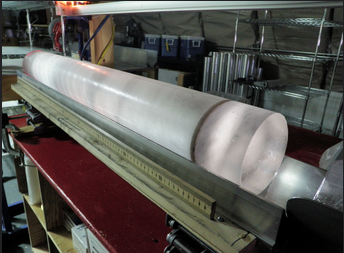Almost as if air from the past had been saved in a time capsule, a drill developed at the University of Wisconsin is able to capture air in ice from thousands of years ago to measure ancient atmospheres.
Assistant geoscience professor at UW Shaun Marcott said his longterm project had to do with measuring carbon dioxide from a 12,000-foot ice core in Antarctica. He said he kept all the ice to take measurements from the air trapped inside.
“It literally is air from the past. In this particular ice core we have air from 17,000 years ago, others have gone back much further,” Marcott said. “Because we have the air from the prior atmosphere, we can measure a lot of things, carbon dioxide and methane in particular. How they change through time, they being powerful greenhouse gases.”
Marcott said his goal with this research has been to measure how carbon dioxide and methane has changed in the last 20,000 years. He said some of these measurements have been taken before, but this ice core method allows for more detailed measurements in time, rather than getting measurements every 100 years or every decade. He said it’s generated 10 times more data than what has been able to be done in the past.
He said in 30 episodes, carbon dioxide jumps by about 10-15 parts per million, which is actually small compared to what is going on today. Today, carbon dioxide is going up two parts per million per year, 10 times faster than anything observed in the past.
“So it’s relatively slow compared to today, everything we’ve known about how carbon dioxide is put into the atmosphere,” Marcott said. “It’s happening much quicker than we thought it could. The carbon dioxide is telling us a deeper story of what’s going on with the global carbon cycle.”
At the same time as the jumps in carbon dioxide, Marcott noted two other observations. One is that methane also drastically decreases and the other is records from the ocean, how the ocean mixes and reorganizes. The overturning rate of the ocean begins to rapidly increase during these events, he said.
“Carbon dioxide goes up quickly, methane goes up really quickly and the ocean rapidly changes. Carbon dioxide is thought to be primarily from the ocean, methane is most certainly from land,” Marcott said. “Something is happening globally that is affecting carbon dioxide and methane. We are gong from an ice age to rapidly warm levels of the globe, going through a major shift in what the Earth looks like.”
The new finding in those changes, Marcott said, is going to be a period that is particularly warm. That transition takes about 10,000 years, and what is being found now is that it is happening in 100 years, maybe faster, he said.
“We don’t actually fully understand why these changes are occurring, it’s just the observation that we weren’t able to make before,” Marcott said.


